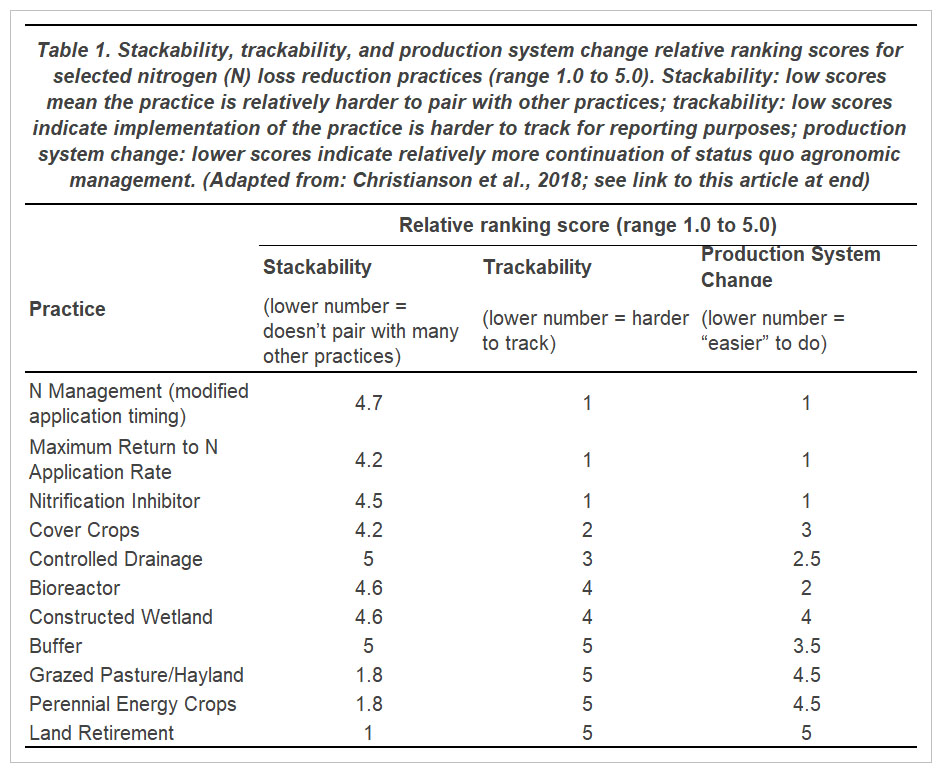Conservation Practices to Reduce Nutrient Loss: How Do They “Stack” Up?
Conservation practices recommended to reduce nutrient loss from fields are generally classified as in-field practices, edge-of-field practices, and land use change practices. Each practice has a different effectiveness for reducing nutrient loss as well as different associated costs and cost efficiencies. Beyond these important differences, there are several additional details about each practice — level of change required, stackability, and trackability — that are important to consider when weighing options to improve water quality.
The adoption or implementation of any conservation practice will necessarily require a change from a given status quo. Some recommended practices, such as converting corn or soybean acres to perennial energy crops or pasture, will be relatively major shifts from conventional agricultural management. Other practices, like shifting nitrogen fertilizer applications from the fall to the spring, will be relatively smaller changes.
Another consideration is that some practices can be layered with other practices so that the practices are essentially “stacked” together. The “stack-ability” of a practice refers to the fact that some practices pair naturally together, while others may actually be mutually exclusive. For example, in-field and edge-of-field practices are often highly compatible, but a denitrifying woodchip bioreactor and a constructed wetland would generally not treat the same drainage outflow, at least at the field scale (that is, they might be mutually exclusive).
“Track-ability” is a third important concept. It will take time for water quality improvement occurring at the field and farm scale to accumulate to significant levels at the watershed scale and then eventually migrate to the Gulf of Mexico to ultimately reduce the size of the annual hypoxic zone. This, after all, is the goal of reducing nutrient loss from fields in the Mississippi River basin. Tracking the adoption of recommended practices is important for states and federal agencies to quantify progress toward Gulf of Mexico hypoxia goals given the lag time to physically observe improved water quality at such a large scale. However, the implementation of some types of conservation practices is harder to track than others. For example, conservation practices that are adopted without federal incentive payments present a significant challenge for tracking and reporting purposes.
A recent study compared these three aspects (production system change, stackability, and trackability) of recommended conservation practices used to reduce nutrient loss to the Mississippi River (Table 1). Practices like modifications to nitrogen fertilizer management (for example, shifting application from the fall to the spring) require relatively low production system change and are highly stackable with other practices. However, this is a difficult practice to track for reporting purposes because this is often a privately made decision (Table 1). At the other end of the spectrum, land use change practices such as land retirement or conversion to perennial energy crops generally require a large production system change from a conventional status quo, but are relatively easy to track using freely available aerial imagery. These practices tend to be highly effective in reducing nutrient loss, so there is no need for them to be highly stackable. Tile drainage-specific practices like denitrifying woodchip bioreactors, controlled drainage, and constructed wetlands pair well with many in-field practices like cover crops (high stackability; Table 1) and implementation of these practices is relatively easy to track via contracts for federal incentive programs (for example, the USDA NRCS Environmental Quality Incentives Program).

Graphing these relative ranking scores against both practice effectiveness and cost effectiveness illustrates that the most effective nitrogen loss reduction practices (that is, the land use change practices) have low stackability, high trackability, and generally require significant production system change from a conventional corn/soybean rotation (Figure 1a, green shaded oval). These practices also tended to be less cost-effective on an area basis (Figure 1b, green shaded oval). The most cost-effective practices (for example, modified N management) tended to be highly stackable with other practices (Figure 1b, pink shaded oval). It is possible that stacking a variety of practices may be the most cost-effective use of conservation dollars, especially for interim water quality goals which have a timeframe that might make wholesale production system changes challenging for many producers. Additional field-scale research to more fully understand agronomic and environmental trade-offs and synergies between recommended practices that are stacked together is required.

This information is abbreviated from the journal article:
Christianson, R., L. Christianson, C. Wong, M. Helmers, G. McIsaac, D. Mulla, and M. McDonald. 2018. Beyond the nutrient strategies: Common ground to accelerate water quality improvement in the Upper Midwest. Journal of Environmental Management 206:1072-1080.
This article is available open access here: https://www.sciencedirect.com/science/article/pii/S0301479717311271
Disclaimer: We request all readers, electronic media and others follow our citation guidelines when re-posting articles from farmdoc daily. Guidelines are available here. The farmdoc daily website falls under University of Illinois copyright and intellectual property rights. For a detailed statement, please see the University of Illinois Copyright Information and Policies here.







